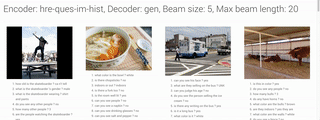Code for the paper
Visual Dialog
Abhishek Das, Satwik Kottur, Khushi Gupta, Avi Singh, Deshraj Yadav, José M. F. Moura, Devi Parikh, Dhruv Batra
arxiv.org/abs/1611.08669
CVPR 2017 (Spotlight)
Visual Dialog requires an AI agent to hold a meaningful dialog with humans in natural, conversational language about visual content. Given an image, dialog history, and a follow-up question about the image, the AI agent has to answer the question.
Demo: demo.visualdialog.org
This repository contains code for training, evaluating and visualizing results for all combinations of encoder-decoder architectures described in the paper. Specifically, we have 3 encoders: Late Fusion (LF), Hierarchical Recurrent Encoder (HRE), Memory Network (MN), and 2 kinds of decoding: Generative (G) and Discriminative (D).
If you find this code useful, consider citing our work:
@inproceedings{visdial,
title={{V}isual {D}ialog},
author={Abhishek Das and Satwik Kottur and Khushi Gupta and Avi Singh
and Deshraj Yadav and Jos\'e M.F. Moura and Devi Parikh and Dhruv Batra},
booktitle={Proceedings of the IEEE Conference on Computer Vision and Pattern Recognition},
year={2017}
}
All our code is implemented in Torch (Lua). Installation instructions are as follows:
git clone https://github.com/torch/distro.git ~/torch --recursive
cd ~/torch; bash install-deps;
TORCH_LUA_VERSION=LUA51 ./install.sh
Additionally, our code uses the following packages: torch/torch7, torch/nn, torch/nngraph, Element-Research/rnn, torch/image, lua-cjson, loadcaffe, torch-hdf5. After Torch is installed, these can be installed/updated using:
luarocks install torch
luarocks install nn
luarocks install nngraph
luarocks install rnn
luarocks install image
luarocks install lua-cjson
luarocks install loadcaffe
luarocks install luabitop
luarocks install totem
Installation instructions for torch-hdf5 are given here.
Although our code should work on CPUs, it is highly recommended to use GPU acceleration with CUDA. You'll also need torch/cutorch and torch/cunn.
luarocks install cutorch
luarocks install cunn
The preprocessing script is in Python, and you'll need to install NLTK.
pip install nltk
pip install numpy
pip install h5py
python -c "import nltk; nltk.download('all')"
VisDial v0.9 dataset can be downloaded and preprocessed as follows:
cd data
python prepro.py -download 1
cd ..
This will generate the files data/visdial_data.h5 (contains tokenized captions, questions, answers, image indices) and data/visdial_params.json (contains vocabulary mappings and COCO image ids).
Since we don't finetune the CNN, training is significantly faster if image features are pre-extracted. We use image features from VGG-16. The model can be downloaded and features extracted using:
sh scripts/download_vgg16.sh
cd data
# For all models except mn-att-ques-im-hist
th prepro_img.lua -imageRoot /path/to/coco/images/ -gpuid 0
# For mn-att-ques-im-hist
th prepro_img_pool5.lua -imageRoot /path/to/coco/images -gpuid 0
This should generate data/data_img.h5 containing features for COCO train and val splits corresponding to VisDial v0.9.
Finally, we can get to training models! All supported encoders are in the encoders/ folder (lf-ques, lf-ques-im, lf-ques-hist, lf-ques-im-hist, hre-ques-hist, hre-ques-im-hist, hrea-ques-im-hist, mn-ques-hist, mn-ques-im-hist, mn-att-ques-im-hist), and decoders in the decoders/ folder (gen and disc).
Generative (gen) decoding tries to maximize likelihood of ground-truth response and only has access to single input-output pairs of dialog, while discriminative (disc) decoding makes use of 100 candidate option responses provided for every round of dialog, and maximizes likelihood of correct option.
Encoders and decoders can be arbitrarily plugged together. For example, to train an HRE model with question and history information only (no images), and generative decoding:
th train.lua -encoder hre-ques-hist -decoder gen -gpuid 0
Similarly, to train a Memory Network model with question, image and history information, and discriminative decoding:
th train.lua -encoder mn-ques-im-hist -decoder disc -gpuid 0
The training script saves model snapshots at regular intervals in the checkpoints/ folder.
It takes about 15-20 epochs to train models with generative decoding to convergence, and 4-8 epochs for discriminative decoding.
We evaluate model performance by where it ranks human response given 100 response options for every round of dialog, based on retrieval metrics — mean reciprocal rank, R@1, R@5, R@10, mean rank.
Model evaluation can be run using:
th evaluate.lua -loadPath checkpoints/model.t7 -gpuid 0
Note that evaluation requires image features data/data_img.h5, tokenized dialogs data/visdial_data.h5 and vocabulary mappings data/visdial_params.json.
We also include code for running beam search on your model snapshots. This gives significantly nicer results than argmax decoding, and can be run as follows:
th generate.lua -loadPath checkpoints/model.t7 -maxThreads 50
This would compute predictions for 50 threads from the val split and save results in vis/results/results.json.
cd vis
# python 3.6
python -m http.server
# python 2.7
# python -m SimpleHTTPServer
Now visit localhost:8000 in your browser to see generated results.
Sample results from HRE-QIH-G available here.
All files available for download here.
visdial_data.h5: Tokenized captions, questions, answers, image indicesvisdial_params.json: Vocabulary mappings and COCO image idsdata_img.h5: VGG16 image features for COCOtrainandval
Model checkpoints available here.
hre-qih-d.t7: Hierarchical Recurrent Encoderhrea-qih-d.t7: Hierarchical Recurrent Encoder with Attentionmn-qih-d.t7: Memory Networklf-qih-d.t7: Late Fusion
hre-qih-g.t7: Hierarchical Recurrent Encoderhrea-qih-g.t7: Hierarchical Recurrent Encoder with Attentionmn-qih-g.t7: Memory Networklf-qih-g.t7: Late Fusion
BSD

